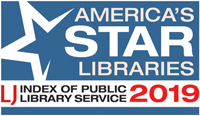What’s Next: Electronic Information Retrievals | Star Libraries 2019
In FY16, the IMLS Index of Public Library Service PLS added a new data element for successful retrieval of electronic information, as distinct from circulation of ebooks. By next year, all states will have been collecting data on the measure for at least two years, so electronic information retrievals may become the seventh per-capita statistic in the LJ Index formula next year. This will be a useful measure of how people are using library resources and what kind of content they need or want.
 In FY16, the Institute of Museum and Library Services (IMLS) Index of Public Library Service (PLS) added a new data element for successful retrieval of electronic information, as distinct from circulation of ebooks. Mostly this consists of full content from licensed databases, downloaded or fully displayed, such as journal articles; reference content, such as dictionary definitions, encyclopedia articles, or biographies; and non-text resources, such as images, audio, and video. It includes use both inside and outside the library, but not use of the OPAC or website. By next year, all states will have been collecting data on the measure for at least two years, so electronic information retrievals may become the seventh per-capita statistic in the LJ Index formula next year. This will be a useful measure of how people are using library resources and what kind of content they need or want.
In FY16, the Institute of Museum and Library Services (IMLS) Index of Public Library Service (PLS) added a new data element for successful retrieval of electronic information, as distinct from circulation of ebooks. Mostly this consists of full content from licensed databases, downloaded or fully displayed, such as journal articles; reference content, such as dictionary definitions, encyclopedia articles, or biographies; and non-text resources, such as images, audio, and video. It includes use both inside and outside the library, but not use of the OPAC or website. By next year, all states will have been collecting data on the measure for at least two years, so electronic information retrievals may become the seventh per-capita statistic in the LJ Index formula next year. This will be a useful measure of how people are using library resources and what kind of content they need or want.
The status of this new measure is already strong: This statistic is being reported by more than nine out of ten public libraries that qualified for an LJ Index score this year. Two out of three report a value greater than zero. Only a quarter report zero electronic retrievals. And only about one out of 12 does not report this figure at all. Generally, libraries with higher operating expenditures are more likely to report e-retrievals (almost all spending more than $10 million) and libraries with lower expenditures are less likely to report e-retrievals (still, almost nine out of ten even for the lowest expenditure category).
 At the state level, there is even stronger evidence that e-retrievals as a new measure is being adopted remarkably quickly. All libraries with 2019 LJ Index scores reported non-zero values for this new statistic in the District of Columbia and 11 states: Delaware, Georgia, Hawaii, Idaho, Louisiana, Mississippi, North Carolina, Ohio, Rhode Island, South Carolina, and Wyoming. All libraries with 2018 LJ Index scores reported e-retrievals—including reports of zero—in another 20 states: Arkansas, Iowa, Kansas, Kentucky, Maryland, Michigan, Missouri, Montana, North Dakota, Nebraska, New Hampshire, Nevada, New York, Oklahoma, Oregon, Pennsylvania, South Dakota, Tennessee, Texas, and Wyoming. Other states have reports from most libraries. The only states with substantial percentages of libraries not reporting e-retrievals are Maine (84.8 percent), Utah (75.6 percent), Minnesota (59.2 percent), and Connecticut (46.2 percent).
At the state level, there is even stronger evidence that e-retrievals as a new measure is being adopted remarkably quickly. All libraries with 2019 LJ Index scores reported non-zero values for this new statistic in the District of Columbia and 11 states: Delaware, Georgia, Hawaii, Idaho, Louisiana, Mississippi, North Carolina, Ohio, Rhode Island, South Carolina, and Wyoming. All libraries with 2018 LJ Index scores reported e-retrievals—including reports of zero—in another 20 states: Arkansas, Iowa, Kansas, Kentucky, Maryland, Michigan, Missouri, Montana, North Dakota, Nebraska, New Hampshire, Nevada, New York, Oklahoma, Oregon, Pennsylvania, South Dakota, Tennessee, Texas, and Wyoming. Other states have reports from most libraries. The only states with substantial percentages of libraries not reporting e-retrievals are Maine (84.8 percent), Utah (75.6 percent), Minnesota (59.2 percent), and Connecticut (46.2 percent).
PAIN POINTS
State library agencies already achieving 100 percent reporting of electronic information retrievals were asked what works for them. One clever technological solution to total compliance was simple: “A state edit check was developed to require a response in the Successful Retrieval of Electronic Information question if a library reported databases,” an anonymous spokesperson from the Missouri State Library told LJ.
Even with their success, certain obstacles came up again and again. Lack of standard terminology across vendor platforms and reports was the most frequent complaint. Norma Fowler, Nevada SDC, gives a telling example of “lack of standardization or consistency between vendors about the elements that are reported and the terms that are used for the elements.” She says: “We provide databases from three vendors. Between the three of them, they use the following terms in their usage reports: Hits, Sessions, Content Views, Searches, Regular Searches, Federated and Automated Searches, Result Clicks, Record Views, Full Text Requests, Abstract Requests, and Link-out Requests. We select the elements that seem to meet the PLS definition of “successful retrievals” and use those elements for the statewide databases, but it is unclear if we are using the same elements as other states. Also, the question of how to count pay-per-use vendors has not been resolved.”
Databases provided through state libraries and consortia are generally easier to track than resources subscribed to at the local level, with many states prepopulating those fields. But while several state libraries provide charts attempting to guide individual systems to decide which data elements to report where, they report widespread confusion about what counts as a database use versus an electronic circulation, and concern that different libraries are applying the criteria inconsistently.
|
PUBLIC LIBRARIES ON THE LJ INDEX 2019 BY REPORTING ON ELECTRONIC INFORMATION RETRIEVALS, FY17 |
||||||||
|
EXPENDITURE |
ELECTRONIC INFORMATION RETRIEVALS |
|||||||
|
GREATER THAN ZERO |
ZERO | MISSING | TOTAL | |||||
|
NUMBER |
PERCENT | NUMBER | PERCENT | NUMBER | PERCENT | NUMBER |
PERCENT |
|
| $30M + | 50 | 90.9 | 4 | 7.3 | 1 | 1.8 | 55 | 100 |
| $10M–$29.9M | 104 | 92.9 | 4 | 3.6 | 4 | 3.6 | 112 | 100 |
| $5M–$9.9M | 163 | 84.9 | 12 | 6.3 | 17 | 8.9 | 192 | 100 |
| $1M–$4.9M | 1,069 | 85.5 | 132 | 10.6 | 50 | 4 | 1,251 | 100 |
| $400K–$999.9K | 949 | 77.7 | 197 | 16.1 | 75 | 6.1 | 1,221 | 100 |
| $200K–$399.9K | 703 | 68.3 | 228 | 22.1 | 99 | 9.6 | 1,030 | 100 |
| $100K–$199.9K | 607 | 58.1 | 315 | 30.2 | 122 | 11.7 | 1,044 | 100 |
| $50K–$99.9K | 401 | 45.2 | 373 | 42 | 114 | 12.8 | 888 | 100 |
| $10K–$49.9K | 197 | 36.5 | 284 | 52.6 | 59 | 10.9 | 540 | 100 |
| TOTAL | 4,243 | 67 | 1,549 | 24.5 | 541 | 8.5 | 6,333 | 100 |
|
KEY: M–Millions K–Thousands |
||||||||
FURTHER FUTURE
With the addition of this data element, there will be only one, long-awaited digital service measure still missing: visits to library websites. That measure is being introduced to the PLS for FY18, so it probably will not be added to the LJ Index until the 2022 edition. But while that is the last technological measure the field has been waiting for, it’s far from the last measure some would like to see added to the survey. As Amanda Johnson, North Carolina SDC, sums up, “We would also like to see the survey reflect how libraries are expanding services through partnerships and outreach services, as well as providing spaces for community use.”
As libraries take on increasingly vital roles as community builders in shifting times, it’s a topic worth considering.
RELATED
ALREADY A SUBSCRIBER? LOG IN
We are currently offering this content for free. Sign up now to activate your personal profile, where you can save articles for future viewing









Add Comment :-
Comment Policy: